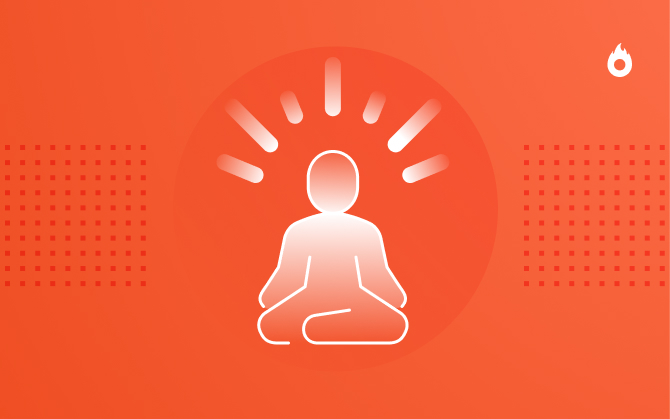
What is mindfulness and how can it improve my work?
Find out how to put the theory of mindfulness into practice!

What will we see in this post
Professionals and students alike need to keep alert and stay on the ball throughout the day. This is vital in the learning process and to deliver top results. However, due to all kinds of factors, it’s never been harder to pay attention– that is to say, to maintain mindfulness.
Imagine that you’re writing an email. You’re concentrated and everything is flowing easily. Then, your phone starts beeping to let you know you got a message. You try to resist, but can’t. You shift your focus and leave the email for later.
Examples like this are common in our day to day lives. Our attention is bombarded with offers, messages, schedule alerts and invites. If not well managed, all of these variables make even the best professional less productive, less happy, and more prone to deliver results well off the mark.
This is why we need to train our attention. We need to focus on what’s really important!
Learning how to say “no,” making a GUT to-do list every day and using sound time management are all great tips, but there are many more. We’re going to explore all of these options in this article!
After all, what really is mindfulness?
Head in the clouds and a wandering mind
A quick question: are you thinking about something else right now? If your answer is yes, don’t worry. Actually, it’s more common than you think. Most people’s minds are constantly wandering far from what they’re really doing.
This was shown by psychologists Mathew Killingworth and Daniel Gilbert. They created an iPhone app that asked this same question at random moments throughout the day to 2,250 men and women. Nearly 50% of the time these folks were thinking about something else. The study was published in the esteemed journal Science.
Another question: how many times have you gotten distracted while reading this article? Not easy to answer with an exact number, is it?
Three researchers studied this topic and found that the mind of a reader, that is to say, you at this very moment, gets distracted around 40% of the time.
And it’s because you’re busy thinking about other things half the time or because your mind is wandering while reading right now, that you and your work are suffering.
In the short run, being absent-minded results in little mistakes and delays. But, if this persists for a month, year, or your entire life, the results are troublesome.
The concept of Mindfulness
But in the end, what is mindfulness? It’s a state of mind where you train your attention to be here and now.
In this sense, mindfulness is something you can reach many times throughout the day — and even more easily lose it thanks to all of the distractions. But there are some techniques we can take advantage of to better police our busy minds, putting them more and more in the here and now.
There is no clear consensus on where true mindfulness comes from. Some think it’s only found through Buddhist meditation, while others argue for psychological techniques such as contextual psychotherapy. Either way, this isn’t our main concern. We’re more interested, for this article, in showing the benefits and how to reach this state of greater awareness.
Mindfulness increases self-control, among various other benefits
In the well-known marshmallow test, psychologist Walter Mischel asked four-year-olds to choose a treat from a basket full of marshmallows and other sweets. After choosing, the children could eat the candy on the spot, or, if they waited a few minutes, they would receive two pieces of candy.
About a third of the kids devoured the candy right away, while another third waited for 15 minutes in order to get another piece of candy. When evaluating the children who showed greater ability to wait, the researchers found they had high levels of self-control, especially in the category of attention.
In this case, it’s easy to make the connection between attention management and self-control and how these can bring about an enormous amount of benefits. Some of the highlighting perks are:
- higher quality of life;
- better career performance;
- delivery of better results;
- better at meeting deadlines and at higher standards;
- greater day-to-day productivity;
- less procrastination;
- less impulsiveness in decision making.
In light of this, obtaining mindfulness can create various benefits. In the short term, you can get more done every day while maintaining a higher quality of life. In the long term, you’ll see drastic improvements personally and professionally. All of these benefits have been well documented by way of research and observation.
7 tips to reach a state of mindfulness
1. Know when to say “no”
First, you need to know how to say no. While you’re doing things that really are important, there is always an army of things fighting to distract you: your phone, social networks or a nagging friend. As long as you say “yes” to these distractions, you’ll never reach mindfulness.
So, avoid overwhelming yourself with less important activities. As much as you want to come across as open and nice, learn to say no. Stop trying to do everything at once. By doing this, there is a much better chance of you concentrating more and getting things done.
2. Improve your time management
Good time management is a determinant of mindfulness. When you live just to “put out fires,” you’ll never be able to carry out your tasks with quality, much less be mindful. This is why it’s worth using some time management tools.
One of the best tools is the time management matrix. This divides your daily tasks into four quadrants: urgent/important, not urgent/important, urgent/not important, not urgent/not important. The ideal is when a good part of your tasks are under the category of not urgent/important. This way you can plan and carry out things with care and quality.
3. Have a mantra
The daily overload of information seems to create chaotic situations in which it’s hard to reach a state of mindfulness. Quickly, you get overwhelmed and confused. Your mind starts to wander off and now you need to bring it back.
At these times, the use of a mantra can come in handy. For instance, repeat here and now or keep focused over and over until you’ve regained your attention on what needs to be done. It should be a mantra which is easy to remember and feels good to say.
4. Avoid interruptions
The greatest threats to focused attention are interruptions, which are also the most common. For example, you start reading and suddenly a telephone rings and completely breaks your train of thought. After this, it’s hard to get back to the same level of concentration.
So always look for a quiet place, put your phone on silent mode, use headphones, or find other tricks to avoid interruptions. By doing what you need to do without any setbacks, you can reach and keep a state of mindfulness.
5. Use technology to your favor
Most of the time technology is seen as a negative point for good concentration. It shifts your focus from what is important is a thorn in the side of your goal of reaching mindfulness. But it doesn’t always have to be this way. There are a lot of technological tools that can help us concentrate better.
A good playlist can bring more focus, not to mention the wealth of mindfulness and meditation apps that are now out there. So use technology to your favor on your path to mindfulness.
6. Leave time to relax
Day-to-day life can quickly become a rat race. It seems like every hour passes faster than the last and there’s never enough time. This daily stress can wear you out, physically and mentally. All of this adds up, making mindfulness nearly impossible.
With this in mind, it’s important to have a time set aside just to relax. This can be done in all kinds of ways, like reading a good book, watching a movie, going for a walk, finding a hobby or working out at the gym. The important thing is to have a way to release this stress and to recharge your batteries.
7. Know what you’re going to do
Last but not least, a simple tip is to determine what you’re going to do beforehand. For instance, “for the next hour, I will dedicate myself to studying,” or “now, I will sit and relax for at least 20 minutes.” Go ahead and say it out loud if it helps. As you can see, mindfulness is extremely important. Being here and now can help improve the quality of your life, deliver better results, and raise your daily productivity.
Simple tips, like having a mantra, learning to say “no” and using technology to your favor can help a lot. So, don’t forget to use them!
What do you think? Take advantage of here and now to keep learning some more tips to avoid burning out at work. Happy (focused) reading!




